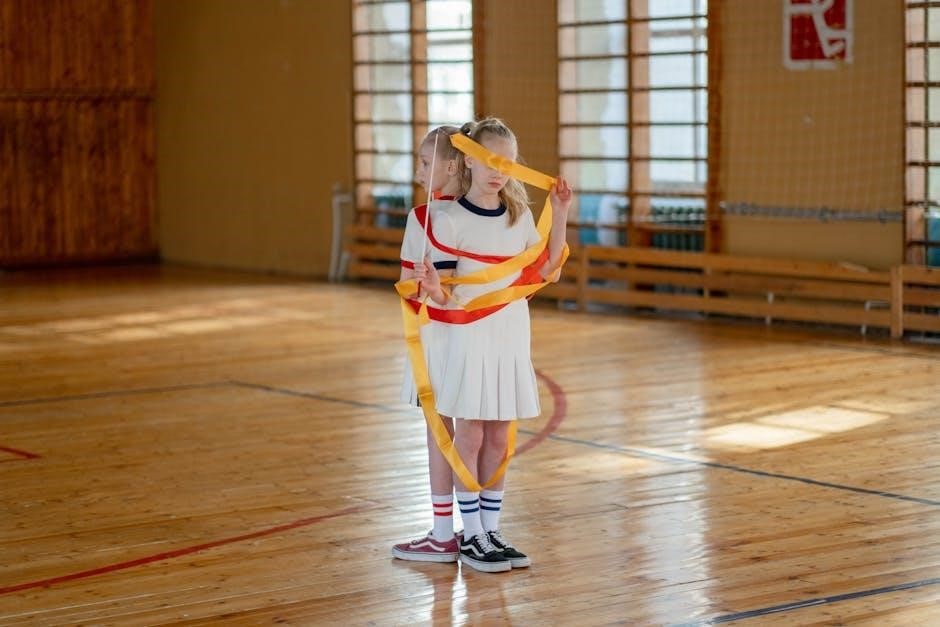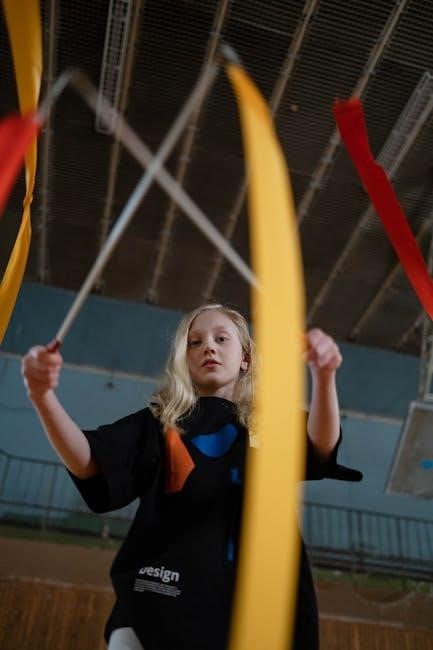Robert Starer’s Rhythmic Training is a comprehensive guide offering progressive exercises from basic notation to complex rhythms, designed for all skill levels to enhance timing, accuracy, and musicality for both educational and performance purposes.
1.1 Overview of Rhythmic Training by Robert Starer
Robert Starer’s Rhythmic Training is a comprehensive guide designed to develop rhythmic accuracy and musicality. It begins with basic rhythmic notation and progresses to complex meters and polyrhythms, offering a structured approach for musicians of all levels. The book includes hundreds of exercises, from simple to advanced, ensuring a thorough understanding and mastery of rhythm in various musical contexts.
1.2 Importance of Rhythmic Training in Music Education
Rhythmic training is fundamental in music education, enhancing timing, precision, and overall musicianship. It bridges the gap between theoretical knowledge and practical performance, allowing students to interpret and execute rhythms confidently. Starer’s method fosters accuracy and freedom, making it an invaluable tool for developing competent musicians capable of mastering complex musical structures and expressing themselves effectively.

Publication Details
Rhythmic Training by Robert Starer was published by Hal Leonard Corporation on September 1, 1985. It is available in PDF, EPUB, and Kindle formats, continuing the foundational work of Basic Rhythmic Training.
2.1 Publisher and Publication Date
Rhythmic Training by Robert Starer was published by Hal Leonard Corporation on September 1, 1985. This work builds on Starer’s earlier Basic Rhythmic Training, offering a structured approach to rhythm education. The book is widely recognized for its practical exercises and is available in PDF format for easy access, making it a valuable resource for musicians and educators worldwide.
2.2 Editions and Formats (PDF, EPUB, Kindle)
Rhythmic Training by Robert Starer is available in multiple formats, including PDF, EPUB, and Kindle, ensuring accessibility across various devices. The PDF version, downloadable from platforms like Z-Library, is particularly popular for its clarity and ease of use. These digital formats allow musicians to practice rhythm exercises anywhere, making the book a flexible resource for modern learners and professionals alike.
Structure of the Book
Robert Starer’s Rhythmic Training features progressive drills, starting with simple rhythms and advancing to complex meters, beat divisions, and polyrhythms, ensuring a comprehensive rhythmic development path for musicians.
3.1 Progressive Rhythmic Drills
The book features a cornerstone of progressive rhythmic drills, beginning with simple exercises and gradually advancing to complex meters, beat divisions, and polyrhythms. These drills are meticulously designed to help musicians master rhythm execution and understanding, ensuring a smooth transition from foundational concepts to advanced rhythmic challenges, thereby building proficiency and confidence in musical performance.
3.2 From Simple to Complex Meters and Polyrhythms
Starer’s method transitions students from basic time signatures to intricate meters and polyrhythms, fostering a deep rhythmic understanding. The exercises systematically introduce complex rhythms, enabling musicians to navigate challenging time signatures and layered rhythms with precision and confidence, thereby enhancing their overall musicality and technical proficiency.
Target Audience
Rhythmic Training by Robert Starer is designed for music students, professionals, and educators, suitable for classrooms, private studios, and self-study, catering to diverse learning environments and needs.
4.1 Music Students and Professionals
Rhythmic Training by Robert Starer is tailored for music students and professionals, offering a structured approach to rhythm mastery. The exercises enhance timing accuracy and musicality, making it invaluable for both educational and performance settings. Suitable for all skill levels, the book bridges theory and practice, providing a comprehensive tool for musicians aiming to refine their rhythmic proficiency.
4.2 Classroom, Private Studio, and Self-Training
Rhythmic Training is versatile, suitable for classrooms, private studios, and self-training. The structured exercises and accompanying resources enable flexible learning. Whether in group settings or individual practice, the book provides a comprehensive approach to rhythm development, catering to diverse learning environments and supporting musicians in achieving rhythmic mastery at their own pace.
Key Features of the Book
Rhythmic Training includes versatile accompanying music files, hundreds of dictation exercises, and a focus on accuracy and competency, making it a valuable resource for musicians seeking to enhance their rhythmic skills.
5.1 Versatile Accompanying Music Files
The book is complemented by downloadable music files, offering accompaniments that enhance rhythmic practice. These files, available in digital formats, provide a dynamic backdrop for exercises, aiding students in developing timing and accuracy. They cater to various skill levels, from basic to advanced, ensuring a comprehensive and engaging learning experience for musicians.
5.2 Hundreds of Dictation Exercises
The book includes numerous dictation exercises designed to refine a musician’s ability to hear and transpose rhythms accurately. These exercises progress from simple to complex, covering various meters and polyrhythms. They are tailored to enhance auditory skills, ensuring students develop precision and confidence in their rhythmic understanding and performance abilities across diverse musical contexts.
5.3 Focus on Accuracy and Competency
Starer’s method emphasizes precision and mastery, providing a structured approach to rhythm. The exercises are crafted to build a strong foundation, ensuring musicians achieve both technical accuracy and artistic expression. This focus helps students progress from basic skills to advanced proficiency, fostering a deep understanding of rhythm and its application in performance.

Benefits of Rhythmic Training
Rhythmic training enhances timing, precision, and overall musicianship, equipping students with the skills to perform complex rhythms confidently and accurately, fostering musical freedom and expression.
6.1 Improving Timing and Precision
Robert Starer’s rhythmic training method focuses on enhancing timing and precision through structured exercises. By practicing rhythmic drills, students develop a stronger internal pulse and accuracy in executing complex rhythms. This systematic approach ensures steady progress, allowing musicians to perform with confidence and consistency. The exercises are designed to challenge and refine timing skills, laying a solid foundation for advanced musical performance.
6.2 Enhancing Musicality and Freedom
Robert Starer’s method fosters musicality by bridging technical precision with expressive freedom. Through structured exercises, musicians gain the ability to interpret rhythms with nuance, allowing for a deeper connection to the music. This approach enables performers to transcend mechanical execution, embracing creativity and spontaneity. Enhanced rhythmic awareness leads to a more natural, intuitive expression of musical phrasing and dynamics.
Integration with Other Music Education Methods
Robert Starer’s rhythmic training complements sight-singing and ear-training approaches, offering a flexible system that enhances musical understanding without relying on specific methodologies, making it adaptable to diverse educational frameworks.
7.1 Compatibility with Sight-Singing Approaches
Robert Starer’s rhythmic training method seamlessly integrates with sight-singing approaches, offering a flexible system that enhances musical understanding. It is not tied to any specific melodic ear-training system, making it adaptable to various educational frameworks. This compatibility allows students to develop rhythmic proficiency while refining their sight-singing skills, creating a holistic musical education experience that bridges theory and practice effectively.
7.2 Use in Conjunction with Ear Training
Starer’s method complements ear training by enhancing the ability to recognize and perform rhythms accurately. The exercises in Rhythmic Training improve aural skills, allowing students to connect rhythmic patterns with melodic structures. This integration strengthens overall musicianship, as students develop both rhythmic precision and the ability to internalize musical phrases, creating a cohesive learning experience that elevates musical understanding and performance quality significantly.

Reviews and Feedback
Rhythmic Training by Robert Starer has received widespread acclaim for its effectiveness in improving rhythmic accuracy and musicality. Educators and musicians praise its structured approach and versatility in enhancing performance skills across various musical disciplines.
8.1 Positive Reception in the Music Community
Rhythmic Training by Robert Starer has been widely praised by musicians and educators for its structured approach to rhythm development. The book’s progressive exercises and versatility have made it a favorite among music schools and professionals. Its ability to enhance timing and accuracy has solidified its reputation as a cornerstone in music education, fostering both technical proficiency and artistic expression.
8.2 Testimonials from Educators and Musicians
Renowned musicians and educators have praised Rhythmic Training for its versatility and effectiveness. Many describe it as a seminal work in music education, emphasizing its ability to enhance rhythmic proficiency. Professionals highlight its practical approach, making it a cornerstone for both classroom instruction and individual practice, ensuring comprehensive rhythm development for students and performers alike.

Availability and Access
Rhythmic Training by Robert Starer is available as a PDF download from various online platforms, including Hal Leonard’s official site, ensuring easy access for musicians worldwide.
9.1 Download Options (PDF and Audio Files)
The book is accessible in PDF format, along with accompanying audio files, available for download from Hal Leonard’s official website, ensuring easy access for musicians to practice and enhance their rhythmic skills effectively.
9.2 Purchase and Library Availability
Rhythmic Training by Robert Starer is available for purchase through Hal Leonard’s official website, major online retailers, and local music stores. The book can also be found in music libraries and educational institutions, making it easily accessible for musicians. It is offered in various formats, including PDF, ensuring convenience for both digital and traditional learners.

Supplementary Materials
The book includes supplementary materials like audio files, available for download, providing rhythmic exercises that support the lessons and enhance practice effectively.
10.1 Accompanying Audio Resources
The accompanying audio resources for Robert Starer’s Rhythmic Training provide a rich supplement to the exercises. These audio files, available for download, include rhythmic patterns and drills that students can practice along with, enhancing their timing and accuracy. The recordings cover a wide range of tempos and time signatures, from simple to complex, allowing for gradual progression. This resource is invaluable for both classroom and self-study environments, offering a practical tool to reinforce the book’s lessons and improve musical performance effectively.
10.2 Online Supplements and Updates
Hal Leonard provides online supplements and updates for Robert Starer’s Rhythmic Training, ensuring access to the latest resources. These include downloadable PDFs, interactive content, and additional exercises, keeping the material fresh and relevant. Regular updates enhance the learning experience, offering students and educators new tools to refine rhythmic proficiency and stay current with evolving music education standards.
Impact on Musical Performance
Robert Starer’s Rhythmic Training enhances musical performance by developing rhythmic proficiency, bridging theory and practice, and fostering accuracy, precision, and musical freedom, elevating overall performance quality.
11.1 Developing Rhythmic Proficiency
Robert Starer’s method systematically builds rhythmic skills through progressive drills, fostering a strong foundation in timing and execution. By mastering complex meters and polyrhythms, musicians achieve proficiency, enhancing their ability to perform with precision and confidence, ensuring a robust rhythmic understanding essential for advanced musical expression and artistry.
11.2 Bridging Theory and Practice
Robert Starer’s approach seamlessly connects theoretical concepts with practical application, ensuring musicians internalize rhythmic principles. Through structured exercises, students transition from understanding notation to executing complex rhythms effortlessly. This integration of theory and practice fosters a deep rhythmic awareness, enabling precise and expressive performances, and equips musicians with the tools to navigate diverse musical demands confidently;
Comparison with Other Rhythmic Training Methods
Robert Starer’s method stands out for its progressive, versatile approach, focusing on accuracy and musicality. Unlike traditional methods, it emphasizes practical application and adaptability, making it a preferred choice for modern musicians seeking comprehensive rhythmic mastery.
12.1 Unique Approach by Robert Starer
Robert Starer’s unique approach in Rhythmic Training combines progressive drills, versatile accompaniments, and dictation exercises. His method bridges theory and practice, offering a structured yet flexible system that enhances timing, precision, and musicality. Unlike traditional methods, Starer’s approach integrates with various learning styles, making it adaptable for classroom, studio, or self-study, ensuring a holistic development of rhythmic proficiency.
12.2 Advantages Over Traditional Methods
Starer’s method surpasses traditional approaches by offering a gradual progression from simple to complex rhythms. It includes versatile audio accompaniments and dictation exercises, fostering both accuracy and musical freedom. Unlike rigid systems, this method adapts to diverse learning environments, making it ideal for classrooms, private studios, and self-training, thus providing a more engaging and effective rhythmic education experience.

Case Studies and Success Stories
Educators and musicians worldwide have reported significant improvement in rhythmic proficiency using Starer’s method. Its practical exercises have transformed classrooms and individual practice, ensuring lasting musical growth and precision.
13.1 Effective Use in Educational Settings
Robert Starer’s Rhythmic Training has been widely adopted in classrooms globally. Educators praise its structured approach, noting improved timing accuracy and rhythmic understanding among students. The book’s versatility allows integration into various music curricula, making it a valuable resource for fostering rhythmic proficiency in group and individual learning environments. Its success is evident in enhanced student performance and confidence.
13.2 Individual Success Stories
Musicians worldwide have credited Robert Starer’s Rhythmic Training with transforming their rhythmic skills. Many report significant improvement in timing accuracy and musicality. Students and professionals alike highlight the book’s ability to bridge theory and practice, enabling them to perform complex rhythms with confidence. Its structured approach has empowered individuals to achieve rhythmic mastery, enhancing their overall musicianship and performance quality.

The Role of Technology in Rhythmic Training
Technology enhances rhythmic training through downloadable PDFs, audio files, and online supplements, providing modern tools for musicians to practice and master rhythm with precision and convenience.
14.1 Digital Tools for Modern Musicians
Digital tools, such as PDF downloads and accompanying audio files, revolutionize rhythmic training by offering convenient access to exercises and resources, enabling musicians to practice and master rhythm with precision and flexibility in both individual and group settings.
14.2 Integration of PDF and Audio Files
The integration of PDF and audio files in Rhythmic Training provides a seamless learning experience, allowing users to follow written exercises while listening to demonstrations, ensuring a deeper understanding of complex rhythms and their execution, thereby enhancing both theoretical knowledge and practical proficiency.
Robert Starer’s Contributions to Music Education
Robert Starer’s work revolutionized music education, offering innovative methods like Rhythmic Training, which bridges theory and practice, enhancing musicians’ skills through structured, accessible exercises, leaving a lasting legacy in pedagogy and performance.
15.1 Legacy and Influence
Robert Starer’s Rhythmic Training has left a profound impact on music education, influencing countless educators and musicians. His methodical approach has set a benchmark for rhythmic accuracy and musical expression, making his work indispensable across generations and musical disciplines. Starer’s legacy continues to inspire new teaching approaches, solidifying his role as a pioneer in modern music pedagogy.
15.2 Other Works and Publications
Beyond Rhythmic Training, Robert Starer authored several influential works, including Basic Rhythmic Training and compositions that blend rhythmic precision with musicality. His publications are celebrated for their clarity and effectiveness, catering to both students and professionals. Starer’s diverse contributions have enriched music education, ensuring his enduring relevance in the field of rhythm and musicianship development.
Rhythmic Training by Robert Starer is a timeless resource for musicians, offering a comprehensive approach to mastering rhythm. Its structured exercises and focus on accuracy make it invaluable for continuous musical growth and understanding.
16.1 Final Thoughts on Rhythmic Training
Robert Starer’s Rhythmic Training is a transformative resource that bridges theory and practice, offering musicians a structured path to rhythmic proficiency. By progressing from simple to complex exercises, it enhances timing, accuracy, and musical freedom, making it an indispensable tool for students and professionals alike in their musical journey and performance excellence.
16.2 Encouragement for Further Study
Musicians are encouraged to delve deeper into rhythmic exploration, leveraging Starer’s exercises as a foundation. Exploring supplementary materials, such as audio resources and online tools, can enhance learning. Embracing technology and diverse musical genres further enriches rhythmic understanding. Consistent practice fosters confidence and creativity, making rhythmic mastery a lifelong, rewarding journey for all musicians.
